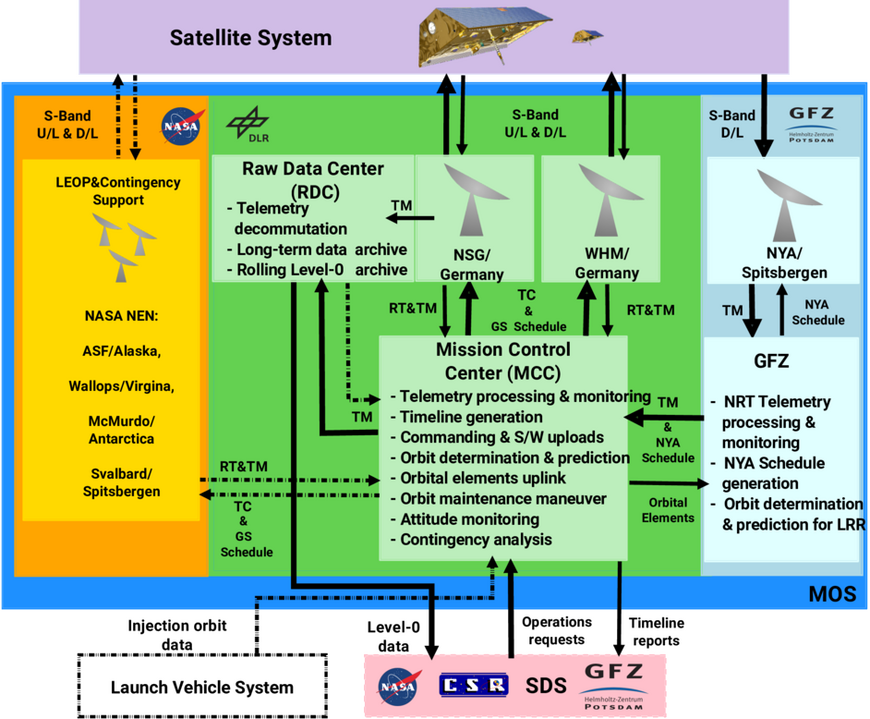Mission Operations System and Mission Phases
The GRACE-FO Mission Operations System (MOS) and Ground Data System (GDS) are funded by GFZ (for the first 5 years) and sub-contracted to DLR’s (DeutschesZentrum für Luft- und Raumfahrt) German Space Operation Center (GSOC) in Oberpfaffenhofen. GFZ provides the Operations Mission Manager (OMM), validated flight procedures and the Ny-Ålesund/Spitzbergen (NYA) ground station complex.
The MOS/GDS consists of the people, processes and procedures, facilities, and ground hardware and software required to operate the GRACE-FO Flight Segment (FS). These capabilities are used to monitor and control the satellite, perform initial processing of the telemetry data, and to deliver all data to the Science Data System (SDS) for further processing and generation of science products. The combination of the ground hardware and software is the Ground Data System (GDS).
The GDS is composed of the:
- Ny-Ålesund/Spitzbergen (NYA) ground station complex operated by GFZ
- Weilheim/Germany (WHM) ground station complex operated by DLR
- Neustrelitz/Germany (NSG) ground station complex operated by DLR
- Mission Control Center (MCC) located at DLR’s German Space Operations Center (GSOC) in Oberpfaffenhofen/Germany and
- Raw Data Center (RDC) operated by DLR at Neustrelitz/Germany.
Additionally MOS/GDS will make use of the following stations (if required):
- O’Higgings/Antarctica (OHG) ground station complex operated by DLR
- Inuvik/Canada (INU) ground station complex operated by DLR.
The five distinct GRACE-FO mission phases can be described as follows:
Pre-Launch (Test and Integration)
The Pre-Launch Phase C/D (Design & Development) starts about 3.5 years before launch. During this phase schedules are negotiated and the system is designed and developed. The phase begins with building and integrating subsystems and experiments into the spacecraft. In a process called ATLO (Assembly, Test, and Launch Operations) the spacecraft is assembled, integrated, and tested in a simulated space environment. Additionally, ground systems to support the mission are developed in parallel with the satellites, and are exercised along with the spacecraft during tests.
Launch and Early Operations Phase
The Launch and Early Operations Phase (LEOP) will last up to 15 days. The GRACE-FO satellites will be launched together on a single launch. Once in the desired orbit, the satellites will be simultaneously released from the upper stage of the launch vehicle, separated and start transmitting to the ground. During LEOP the basic satellite functions (incl. MWI-GPS) will be checked. At the end the satellites are insafe, stable orbits using nominal attitude control and nominal uplink and downlink communications are achieved. No anomalies exit that pose a near-term threat to the mission. The satellites will have a nominal separation distance of 220 km ± 50 km.
In-Orbit Checkout Phase
The In-orbit Checkout Phase (IOC) will last until 90 days after launch and will focus on the power-up, evaluation and calibration of the Science instruments.
Science Phase
In the Science Phase, instrument data will be routinely gathered and processed. This phase will continue until the end of the mission, and will include brief interruptions for orbit maneuvers and instrument re-calibrations.
A sub-phase is the Validation Phase which will last 120 days and focus on providing an end-to-end characterization of the Science Instrument and Data Systems.
Decommissioning Phase
The Decommissioning Phase is the final phase handling the end of mission. In this phase the satellites will be passivated followed by disposal to atmospheric reentry. Emphasis will be given to limit the generation of orbital debris, to limit the risk to the public and to comply with NASA policy directives as well as U.S. national space policy.


